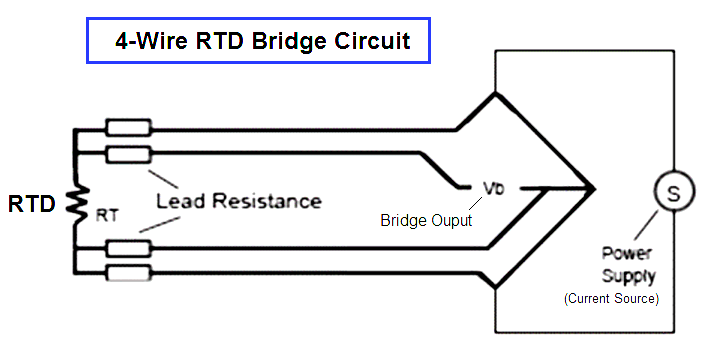RTD measures the temperature in function of variations of its resistance. In order to make them work (4 wire RTD), we need a low current that is called the excitation current.
In fact, T ∝ R and V = IR
So T ∝ V
If I and R both are variable, measuring the temperature based on voltage V will be wrong!
So, to solve this problem we can use the Wheatstone bridge with the known resistors.
That is what has been explained in BS 1041-3: “Measurements are made by passing current through a sensing resistor and measuring the potential across it. If the current is known, the potential is a measurement of the resistance and hence the temperature. If the current is not known exactly the potential may be compared with the potential across a known resistor; this is the basis of the bridge systems.”
Different arrangements of the Wheatstone bridge allow to measure the temperature in different situations with the accuracy that we need. This is something this is known as 2, 3 and 4 wires RTD sensors.
BS 1041-3 proposes that 2-wire RTDs are restricted to a maximum of 1 Ω to 2 Ω per conductor resistance and other forms of bridge (3 and 4-wire) must be used for cable runs of 10 Ω to 15 Ω per conductor (typically 1 km). In fact, 3 or 4-wire form compensate the conductor resistance and its change by changing of temperature.
For example, figure below shows a 4-wire sensor in which red and white wires cancel out blue ones. That allows the bridge to remain balanced even with long run conductors.

In contrast to Wheatstone bridge, BS 1041-3 article 9.3 says that if an accurately-know and constant current source is used to energize the RTD, the temperature can be measured directly by a four-terminal network.
Figure: Simplified RTD Circuit
But in order to prevent that the current passes through voltmeter the input impedance of the potential measuring device must be significantly greater than the RTD. (For example, a 0.1 % error will result from an input impedance 1 000 times the sensor resistance. BS 1041-3)
This method of measurement has some advantages:
1. A temperature-measurement signal in the form of a voltage is available.
2. Several sensors can be connected in series with the same current source.
3. Accurate measurements of resistance can be made if the current is accurately known.
4. Measurements are independent of conductor resistance and selector switch contact resistance.
Author: Hanif Yazdanipoor
Learn the example of flip-flop PLC program for lamps application using the ladder logic to…
In this article, you will learn the STAR DELTA programming using PLC controller to start…
Lube oil consoles of rotary equipment packages in industrial process plants are usually equipped with…
Rotating equipment packages such as pumps, compressors, turbines need the lube oil consoles for their…
This article explains how to blink lights in ladder logic with a detailed explanation video…
In this article, a simple example will teach you the conversion from Boolean algebra to…